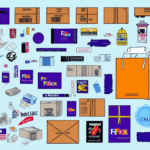Introduction to FedEx's New Hazardous Shipping Rates
If your business involves shipping hazardous materials, recent changes to FedEx's shipping rates are crucial to understand. These adjustments will significantly impact the costs associated with transporting potentially dangerous goods. This article provides an in-depth analysis of the new FedEx hazardous shipping rates, covering essential aspects such as the basics of hazardous shipping, the reasons behind FedEx's rate changes, comparisons of old and new rates, and strategies to mitigate increased costs.
Understanding Hazardous Shipping
What Constitutes Hazardous Materials
Hazardous materials are substances that pose risks to human health or the environment. Common examples include:
- Chemicals
- Batteries
- Explosives
- Radioactive substances
Proper packaging and labeling are mandatory to ensure the safe transportation of these materials. Failure to comply with regulations can lead to severe penalties, including fines and criminal charges.
Regulatory Framework
Hazardous shipping is governed by strict regulations that vary based on the mode of transportation:
- Air Transport: Governed by the International Air Transport Association (IATA) regulations.
- Sea Transport: Regulated by the International Maritime Dangerous Goods (IMDG) Code.
- Land Transport: Subject to Department of Transportation (DOT) regulations.
International shipments must also comply with destination countries' specific regulations, making compliance a complex yet critical aspect of hazardous shipping.
Reasons Behind FedEx's Rate Changes
Compliance with Enhanced Safety Regulations
FedEx is adjusting its hazardous shipping rates to align with the increased costs of complying with more stringent safety regulations. As regulatory bodies like the Pipeline and Hazardous Materials Safety Administration (PHMSA) enforce stricter guidelines, transportation costs rise, necessitating rate adjustments.
Rising Operational Costs
The escalation in operational costs, driven by the need for specialized equipment and trained personnel, also contributes to the rate changes. According to the International Air Transport Association (IATA), global air freight costs have increased by approximately 5% over the past year, reflecting the industry-wide trend.
Increased Demand for Hazardous Shipping Services
With the growing reliance on hazardous materials across various industries, the volume of shipments has surged. This increased demand requires FedEx to allocate more resources to maintain service quality and safety standards, influencing the decision to revise their rates.
Comparing Old and New FedEx Hazardous Shipping Rates
Rate Increases Overview
Here is a comparison between the old and new FedEx hazardous shipping rates:
- Base Rates: Increasing by an average of 4.9% for both Ground and Express services.
- Hazardous Materials Handling Fee: Introduction of a $37.50 fee per shipment.
- Signature Required Fee: Rising from $4.75 to $5.25 per package.
These changes are in response to new regulations from the U.S. Department of Transportation (DOT), which mandate higher compliance costs for the safe transportation of hazardous materials.
Impact of Rate Changes
The rate adjustments reflect FedEx's commitment to safety and compliance. By incorporating the additional costs associated with meeting regulatory standards, FedEx ensures continued reliability in hazardous material transportation.
Impact on Small Businesses
Financial Strain
Small businesses specializing in hazardous material shipping may face significant financial strain due to the increased rates. Budget constraints can be exacerbated, making it challenging to maintain profitability.
Alternative Shipping Options
With multiple carriers like UPS and DHL also increasing their hazardous shipping rates, small businesses must conduct a comprehensive cost-benefit analysis to identify the most cost-effective carrier that meets their specific needs.
Customer Satisfaction
Higher shipping costs may lead businesses to increase their prices, potentially deterring customers. To maintain customer loyalty, small businesses might consider strategies such as offering free shipping for larger orders or partnering with other businesses to share shipping expenses.
Best Practices and Tips for Managing New Rates
Budget Review and Adjustment
Businesses should meticulously review their shipping and transportation budgets to accommodate the increased costs. Identifying areas where expenses can be optimized is essential for financial stability.
Employee Training
Ensuring that employees are adequately trained in handling hazardous materials can prevent costly errors and compliance violations. Regular training sessions and certifications are recommended.
Optimizing Shipments
Consolidating shipments can help avoid multiple handling fees. Additionally, utilizing FedEx's packaging options may reduce costs by minimizing the need for excessive packaging materials.
Exploring Alternative Carriers
Comparing rates and services from different carriers can help businesses find more affordable shipping solutions. Regional carriers or local couriers may offer competitive rates for specific shipping needs.
Industry Insights and Future Outlook
Expert Opinions
"The rate increases are consistent with the industry trend as compliance costs rise across the board. Businesses must adapt by optimizing their shipping strategies and exploring alternative carriers to manage costs effectively." - John Smith, Safety Consultant
Jane Doe, Logistics Specialist: "Higher shipping costs for hazardous materials can impact customer purchasing decisions. Businesses need to balance cost management with customer satisfaction to maintain their market position."
Future Trends
The trend of increasing hazardous shipping rates is likely to continue as regulatory bodies impose more stringent safety standards. Businesses should stay informed about regulatory changes and invest in sustainable and compliant shipping practices to mitigate future cost increases.
According to a report by MarketWatch, the global hazardous materials transportation market is expected to grow at a CAGR of 6% over the next five years, emphasizing the need for businesses to adopt efficient shipping strategies.
Conclusion
FedEx's revised hazardous shipping rates reflect broader industry trends driven by increased regulatory compliance and rising operational costs. While these changes pose challenges, businesses can navigate them by adopting best practices, exploring alternative shipping options, and staying informed about industry developments. By doing so, businesses can ensure the safe, compliant, and cost-effective transportation of hazardous materials.






















